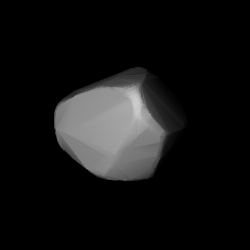Main-belt asteroid
1623 Vivian (provisional designation 1948 PL Themis asteroid from the outer region of the asteroid belt , approximately 25 kilometers in diameter. It was discovered on 9 August 1948, by South African astronomer Ernest Johnson at Johannesburg Observatory in South Africa.[ 11] William P. Hirst .[ 2]
Orbit and classification
Vivian is a C-type asteroid and member of the Themis family , a large family of asteroids with nearly coplanar ecliptical orbits . It orbits the Sun in the outer main-belt at a distance of 2.7–3.6 AU once every 5 years and 7 months (2,035 days). Its orbit has an eccentricity of 0.16 and an inclination of 2° with respect to the ecliptic.[ 1] observation arc begins with its official discovery observation, as no precoveries were taken, and no prior identifications were made.[ 11]
Rotation period and pole
In March 2006, a rotational lightcurve of Vivian was obtained by American astronomer Lawrence Molnar at the Calvin–Rehoboth Observatory in New Mexico. It gave it a rotation period of 20.5209 hours with a brightness variation of 0.85 magnitude (U=3- [ 7] U=n.a. [ 8] [ 9]
Diameter and albedo
According to the surveys carried out by the Japanese Akari satellite and NASA's Wide-field Infrared Survey Explorer with its subsequent NEOWISE mission, Vivian measures between 24.77 and 29.98 kilometers in diameter, and its surface has an albedo between 0.075 and 0.08.[ 4] [ 5] [ 6] Collaborative Asteroid Lightcurve Link assumes an albedo of 0.08 and calculates a diameter of 25.82 kilometers with an absolute magnitude of 11.3.[ 3]
Naming
This minor planet was named in honor of Vivian Hirst, daughter of British astronomer William P. Hirst, receiver of the Astronomical Society of Southern Africa 's Gill Medal and after whom the minor planet 3172 Hirst is named. Hirst calculated the preliminary orbit for this and several other minor planets discovered by Ernest Johnson.[ 2] naming citation was published by the Minor Planet Center on 1 January 1974 (M.P.C. 3569[ 12]
References
^ a b c d "JPL Small-Body Database Browser: 1623 Vivian (1948 PL)" (2017-03-30 last obs.). Jet Propulsion Laboratory . Retrieved 30 June 2017 .^ a b c Schmadel, Lutz D. (2007). "(1623) Vivian". Dictionary of Minor Planet Names – (1623) Vivian . Springer Berlin Heidelberg . p. 129. doi :10.1007/978-3-540-29925-7_1624 . ISBN 978-3-540-00238-3 ^ a b c d e f "LCDB Data for (1623) Vivian" . Asteroid Lightcurve Database (LCDB). Retrieved 28 December 2016 .^ a b c d Nugent, C. R.; Mainzer, A.; Bauer, J.; Cutri, R. M.; Kramer, E. A.; Grav, T.; et al. (September 2016). "NEOWISE Reactivation Mission Year Two: Asteroid Diameters and Albedos" . The Astronomical Journal . 152 (3): 12. arXiv :1606.08923 Bibcode :2016AJ....152...63N . doi :10.3847/0004-6256/152/3/63 ^ a b c d Masiero, Joseph R.; Mainzer, A. K.; Grav, T.; Bauer, J. M.; Cutri, R. M.; Nugent, C.; et al. (November 2012). "Preliminary Analysis of WISE/NEOWISE 3-Band Cryogenic and Post-cryogenic Observations of Main Belt Asteroids" . The Astrophysical Journal Letters . 759 (1): 5. arXiv :1209.5794 Bibcode :2012ApJ...759L...8M . doi :10.1088/2041-8205/759/1/L8 . S2CID 46350317 . Retrieved 28 December 2016 . ^ a b c d Usui, Fumihiko; Kuroda, Daisuke; Müller, Thomas G.; Hasegawa, Sunao; Ishiguro, Masateru; Ootsubo, Takafumi; et al. (October 2011). "Asteroid Catalog Using Akari: AKARI/IRC Mid-Infrared Asteroid Survey". Publications of the Astronomical Society of Japan . 63 (5): 1117– 1138. Bibcode :2011PASJ...63.1117U . doi :10.1093/pasj/63.5.1117 . online , AcuA catalog p. 153 )^ a b Molnar, Lawrence A.; Haegert, Melissa J.; Beaumont, Christopher N.; Block, Marjorie J.; Brom, Timothy H.; Butler, Andrew R.; et al. (March 2008). "Lightcurve Analysis of a Magnitude Limited Asteroid Sample" . The Minor Planet Bulletin . 35 (1): 9– 12. Bibcode :2008MPBu...35....9M . ISSN 1052-8091 . Retrieved 28 December 2016 . ^ a b Durech, J.; Hanus, J.; Oszkiewicz, D.; Vanco, R. (March 2016). "Asteroid models from the Lowell photometric database" . Astronomy and Astrophysics . 587 : 6. arXiv :1601.02909 Bibcode :2016A&A...587A..48D . doi :10.1051/0004-6361/201527573 . S2CID 118427201 . Retrieved 28 December 2016 . ^ a b Hanus, J.; Broz, M.; Durech, J.; Warner, B. D.; Brinsfield, J.; Durkee, R.; et al. (November 2013). "An anisotropic distribution of spin vectors in asteroid families" . Astronomy and Astrophysics . 559 : 19. arXiv :1309.4296 Bibcode :2013A&A...559A.134H . doi :10.1051/0004-6361/201321993 . S2CID 119214895 . Retrieved 28 December 2016 . ^ Veres, Peter; Jedicke, Robert; Fitzsimmons, Alan; Denneau, Larry; Granvik, Mikael; Bolin, Bryce; et al. (November 2015). "Absolute magnitudes and slope parameters for 250,000 asteroids observed by Pan-STARRS PS1 - Preliminary results" . Icarus . 261 : 34– 47. arXiv :1506.00762 Bibcode :2015Icar..261...34V . doi :10.1016/j.icarus.2015.08.007 . S2CID 53493339 . Retrieved 28 December 2016 . ^ a b "1623 Vivian (1948 PL)" . Minor Planet Center . Retrieved 28 December 2016 .^ Schmadel, Lutz D. (2009). "Appendix – Publication Dates of the MPCs". Dictionary of Minor Planet Names – Addendum to Fifth Edition (2006–2008) 221 . Bibcode :2009dmpn.book.....S . doi :10.1007/978-3-642-01965-4 . ISBN 978-3-642-01964-7
External links
